Wrestling the Darkness in Panther Gorge
By Kevin MacKenzie
By Kevin MacKenzie
I had never been to St. Alban, a dedicated dry tooling crag near Quebec City. My friend Marty Theriault, who lives only 10 minutes from the crag, had several times extended an invitation to sample the chossy riverside cliffs. Marty was about to be deployed so we had to make the trip happen soon. – Zac St. Jules.
“Both of us are in disbelief at what just happened. It was positively insane. It’s the last day of our trip and we’re three pitches up this absurdly steep four-pitch wall above the Riviere Sainte-Marguerite, five miles from the road.”
~ Michael Wejchert
Watching Bayard mix climb is always entertaining. The guy’s so strong when he’s rock climbing, he makes massive, dynamic leaps of faith from hold to hold, bouncing upwards with glee on teeny edges until he finishes the climb or falls off, unhampered by any type of discernible fear.
In the wintertime, it’s pretty much the same. Bayard completely trusts those dicey placements most folks cringe while pulling on, swinging from ice tool to ice tool like a prizefighter dancing around a ring before a match. Half the time, he waltzes up something incredible, but half the time a hold breaks or a crampon skitters off and he’s flying through the winter air on a set of well-traveled double ropes. His confidence in gear and his own ability lets him surmount the head games most of us seem to wrangle with in winter mixed climbing.
So that’s one part of the Bayard show.
“I don’t like being told what to do,” Bayard said to me the first time we ever went climbing, as he was driving the wrong way down a one-way driveway in North Conway.
And because Bayard is my boss in the summer renovating houses, and in the winter for Cathedral Mountain Guides, (and because he could pick me up and throw me into a snowbank if he wanted to) I don’t think I’ve ever told him what to do.
So usually, when he neglects the tagline or half the rack and I or another of our partners ends up tossing him the pitons or the number three or the second rope, we just let him do his thing. After all, he’s better than us, and even if he wasn’t, it turns ice climbing into a fascinating sport of coordination, which I suspect he’s after anyways. I guess you can only climb so much M8 trad before you need to make it more interesting.
Repeating a Bayard route still garners the young guns press in New England, though Bayard himself doesn’t have much interest in posting about the climbing he’s doing. Too much time away from hanging out with his wife Anne, or sci fi shows on Netflix, or climbing.
When you get older, you get busy.
The past four years or so, things have gotten in the way of winter climbing. I wish I’d realized how rare it was to have a week, or a day, or a half-day off in the wintertime. My count of personal ice climbing days has dropped into the single-digits in the past two years. As Alexa and I struggle with career changes and hectic schedules, we have to put prospective winter climbing on our calendars. I can’t drop everything when something cool comes in anymore, and it’s frustrating to watch friends with more flexible schedules tramping around the routes I’ve always wanted to do. I’ve probably gotten about 20 days of ice climbing in the past two seasons; the rest is made up of headlamp soloing, Nordic skiing, and dry tooling on our little home wall after work.
In the fall of 2016, I tore my right shoulder’s labrum on a sport climb in Canada. I knew, right away, I’d done something bad, but I thought I could climb through the injury. I wanted to have fun with my friends. I figured I’d be able to get out a little with the little cadre of smack-talking north Conway-ites I’d come to call my regular climbing partners.
If Bayard Russell’s a little blip on the social media radar these days, Ryan “Rhino” Driscoll flies under it entirely. I don’t think the guy’s ever, ever posted about his climbs. Pound for pound, Ryan’s one of the most promising young alpinists in New England. But he still climbs in fleece gloves, he wears black and brown, he’s got a Johnny Waterman-style penchant for substances, and he thinks it’s pretty shameful to post a single photo on Facebook. He hangs out with his dog. The first time I climbed with him, we scratched our way up something in Huntington Ravine.
“That was the best climb I’ve ever done!,” Ryan chirped.
Of course, every climb I’ve done with Ryan since, he’s said the same thing. I quickly realized his steady temperament and tree-trunk legs were the perfect antidote to my twitchy, skinny personality in the mountains.
We worked our way up a few routes in the Canadian Rockies last season. He’s got the head and the endurance for longer climbs, lumbering uphill like a truck in low gear. He and Justin Guarino were hit by a falling snow mushroom on Mount Bradley in Alaska last year, sending them careening 200 meters down the route’s easy upper snow slopes. A rope snagging on a rock band saved their lives. Ryan got up, shook off his smashed Sirocco helmet, made sure Justin was OK, and they kept climbing, too far up the mountain to retreat.
Sponsors should throw him gear but they don’t, choosing instead to go for twitter-happy Instagrammers with half his ability.
“It never happened unless it’s on social media,” we joke, then Ryan goes back to texting his fiancée Angela on his flip phone, wondering about Rupert the dog.
Before my shoulder surgery, I eked out a few climbing days last winter, and the most fun one was the first. Bayard, Ryan, and I trudged up the talus into Huntington Ravine, where there’s some unglamorous mixed climbing to be had, especially when it’s Scottish outside, which it certainly was: freezing cold and blowing us over as we stood racking up. We’ve always adhered to Nick Bullock’s rules up there: no snow, no go. There wasn’t much of a question as to who would lead the crux pitch, and we loaded up Bayard, our senior-most member, up with pitons, a hammer, slings, and hexes and pointed the ringer in the direction of the cliff. He prodded his way up around the crux corner of a route Ryan had checked out the year before; an old, obscure rock climb called Misty.
He banged in a piton and launched. I was hardly paying any attention to the ropes: Bayard would send the pitch and then we’d do the route’s first winter ascent. Just like always! But his tool popped and off he went, a shower of spindrift and ironmongery. The old double ropes stretched, but the piton held, and Bayard lowered off, still in high spirits. If Bayard fell, it meant the route was hard.
“Who’s next?”
I guessed I was, and racked up, scared shitless. I scratched my way up to Bayard’s high point, banged in another piece of gear, and found the hook Bayard had popped off of. My right shoulder flexed. I was scared. I tried to weight the shoulder for a few seconds, unsure if it was the injury or my abilities in general that were holding me back.
“I dunno, guys.”
I lowered gingerly off the piton and we sent Ryan the Rhino up. I cursed myself for not hanging in there a little bit longer.
When Bayard’s on, he’s on. Unstoppable. But, like me, Bayard loves bailing, and when the psyche has been drained, he’s a pretty easy sell for swift retreats. The wind hammered us in the ravine. We took turns soloing the first bit of Cloudwalker to stay warm, belaying Ryan as he inched his way up the pitch. Bayard hadn’t brought any food, and we were running low on calories. Ryan couldn’t hear us through the wind, lost in his own terrifying world.
“Michael.” I saw a twinkle in his eyes through several layers of down.
“Ya Bayard.”
“We could be at the Shannon Door in an hour with pints in our hands. It’s so warm in there.”
“Ohh. Bayard.”
It sounded so good. Ryan clipped our piton. He was about to launch up the crux. He was holding it together really well up there.
“Michael, have you had the BBQ chicken pizza at the Shannon Door?”
I had. It was really good. Ryan had better fall off soon so we could get pizza and beer. I considered yanking on one of the double ropes. Ryan’s pretty thick-skinned. He’s had worse falls.
As luck would have it, poor Ryan had to take in the same spot I’d bailed, shaking his fleece gloves to re-warm his hands. Still, he kept going higher. Past the 10-foot crux, the route became easier, but with little opportunity for good gear. There was a terrifying fifteen feet where he was looking at a massive fall onto the piton.
He finally crawled onto a ledge.
“OFF BELAY,” yelled the Rhino.
“Hey Ryan!” we yelled. “We wanna go to the bar! Leave the anchor and clean the gear and we’ll get outta here.”
“WHAT!?” The poor guy had just worked though the cold for an hour. Now his friends wanted to leave him on New England’s deadliest mountain.
“Michael! They’re your cams in the anchor. Now you two tie in and get up here!”
We sighed, cold, hungry and thirsty, and tied into the ropes. As we kept climbing, our hands warmed up, and Bayard became excited about climbing again. It was getting dark.
“Wanna do another pitch?” We managed to clip half the rack onto Bayard’s harness before he charged ahead like a bull at a rodeo, furiously climbing a corner of neve and turf. The pitch was classic alpine terrain, and we dangled from pitons, fifty feet from the top. None of us had headlamps or puffy coats. It would be dark in twenty minutes or so.
We rappelled, shoving our way through the crowded Shannon Door a few hours later.
For some reason, I thought a lot about our obscure little route in the hot summer days after surgery. I’d bailed on my Alaska partner and went under the knife in April. (Clint ended up climbing one of the wildest routes in Alaska, the south ridge of Huntington, over a week with Jess Roskelley. I think I would have been too scared, anyway.) As the anesthesia pulsed through my veins, my surgeon pulled my arm out of the socket and flopped the useless joint around.
“Oh man. This thing is loose.” I passed out.
That summer I furiously pedaled our exercise bike, unable to leave the house. My shoulder sling sweated and itched. As July turned to August, I worked with my physical therapist to raise my arm above my head.
I started trail running with the bulky sling on. The consequences were like soloing. A single slip would be catastrophic. By the time November rolled around, I’d managed to lead a single 5.9 outside. I was weak and completely filled with self-doubt, afraid of the new anchors holding my labrum together. I’d taken a year off from climbing.
“Wanna go up into Huntington ravine?” Ryan asked one day. I had the day off, and the weather was cold. I did, assuming Ryan would claim his lead and finish the route. Bayard was off in the Canadian Rockies with Raphael Slawinski and Nick Bullock. We figured he wouldn’t mind if we gave our piddly old rock route another go.
As we hiked up the trail, I remembered what it was like to carry a winter rack in my pack. I felt that old feeling rush towards me again, the wind up high carrying the cold air through the thinning spruce trees by the Harvard cabin. Huntington ravine is small and old school, but I’ve loved climbing there for 17 years, ever since my father dragged me up Yale Gully.
The Instagrammers were bludgeoning their way up ice climbs that had been put up when Calvin Coolidge was president. It was winter up here again.
“Want to lead?” Ryan had pulled me up upper refuse, my first climb post-surgery this summer, something most of our friends wouldn’t stoop to climb without a paycheck.
“Really? It’s your pitch. You almost sent it last year.”
“I don’t care at all.” And he didn’t. He just wanted to climb with his friend.
I wasn’t sure if leading an M7 pitch was a good re-introduction to winter, or to leading, for that matter. I tried not to think about it as I hemmed and hawed, hammering in pitons and retreating to rest on the big ledge below the crux. I was taking a long time.
Finally, I forced myself around the corner. My feet cut for a second before I stood on the teeny edges, hammering in a little spectre hook.
You’ve been thinking about climbing for a year. This is gonna be your only shot. All winter. Come on, youth. I cajoled myself.
I committed to the right-handed hook. My tool held, and my new shoulder did, too. I pulled up. I crept past the bad placements, gingerly working my way towards the belay. I finally clipped in to my anchor, worked, and let out a whoop of contentment. I was climbing again!
Ryan sped up the second pitch, and we hung on our old pitons, staring at that final fifty feet. What had looked like fifty easy feet of climbing in last year’s twilight before was anything but. (Winter climbing rule number one: it’s always harder than it looks.) Ryan stated up. It was slabby and scary. At one point, he committed to a turf blob above an overlap, heel hooking his crampon to pull his way up. Perhaps two or three of the six pieces he placed on the pitch might have held. I followed, worked, and fell, dangling on toprope in space. The pitch was steep.
Finally, we were both on top. The shadows grew long in the sky. It would be dark soon again. I’d forgotten my headlamp again, too. We jogged down the trail to the car. A few days later, Ryan and Bayard added a new route to what we’d dubbed the “Rhino Wall,” and I became inundated with work, sneaking out here and there for a few hours of winter fun. I guess when you don’t get to climb a lot, the days start to really matter, but who you get to spend them with matters even more.
Also see https://www.neice.com/2017/03/technical-traverse/
https://www.cathedralmountainguides.com/
.
by Alden Pellett
Ice the size of suitcases crashed down the face in the hot sun. I hunkered below a rock buttress, standing off to the side of 20 Below Zero gully. I had just gotten down off a neighboring route and the sun was increasing in intensity. It was only the middle of November, but I was already climbing classic lines at Lake Willoughby!
At the same time around the Northeast, fellow climbers were also ecstatically sinking tools into early season classic ice like the Black Dike at Cannon cliff in New Hampshire, Grand Illusion in Vermont’s Smuggler’s Notch, and Chouinard’s Gully at Chapel Pond in the Adirondacks. The ice had formed excitingly fast over the past few days.
I stood chewing on a crushed peanut butter sandwich. My crampons scratched on the bare ground. Boom! An acrid smell filled the air as a toaster-sized rock crashed down the slope fifty feet away. It felt more like March than November. Now, right before my eyes, the season seemed to be deteriorating almost as rapidly as it started. I quickly packed my lunch away, grabbed my gear, and hustled through the fallen leaves down to my car.
Back at home, a day had gone by. The forecast did not look good. It was clear that the temperatures at lower altitudes meant some of my favorite climbs hadn’t stuck around. I was given an amazing early taste of winter and was depressed at the thought of having to go back to merely dreaming of steep ice. I fired up the wood stove and sunk into my couch, aimlessly browsing social media. Trump, ‘snowflakes,’ North Korea, gun control, blah, blah, blah. None of it seemed to matter. I wanted my ice climbing back, and my out-of-shape, old-man calf muscles from the past couple of days climbing weren’t helping me forget it.
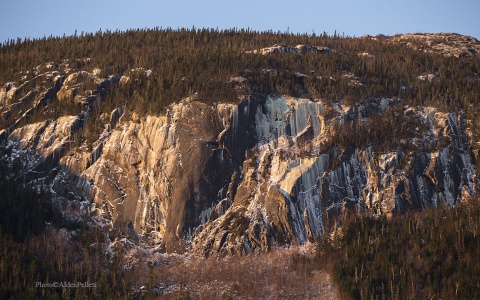
The Mur des Crapaud Wall in Parc National des Grand Jardins in Quebec. Photo by Alden Pellett
Suddenly a glimmer of hope flashed across my computer screen. A Canadian friend to the north posted photos from his own weekend outing. The big crags in the background of some of his pictures had long runnels of shaded ice snaking over five hundred feet down the faces. In another image, steep yellow ice flowed several hundred feet down to talus and trees. I had seen these classics in the ice guidebook for Quebec, but would the ice still be there? Smiling faces in his warm, sunlit photos told me, ‘No,’ but hope flickered there. I checked the forecast. I sent a message. I read the guidebook. I sent another message. I got up and put another log on the fire and sat forward on the couch. His answer came. It was “Yes!” The climbs should still be there! My fingers working quickly, I sent one more message and my buddy Ryan replied. He had time off too and was game for heading north. We would escape this warm up by driving north of the border.
The Parc National des Grand Jardins (Great Gardens) lies about an hour north of Quebec City, traveling through farm country to the quaint tidy town of Ste.-Urbain. This 120-square mile park is loaded with boreal forest, wildlife, tundra, and scenic granite faces.
Wednesday morning, the alarm goes off at our Motel in Baie St. Paul. Ryan fires up the Jet Boil to make hot tea for the day ahead. We had arrived at 9 p.m. the night before, spending an hour sharpening tools and prepping gear before hitting the hay. After wolfing down a speedy breakfast at the ubiquitous Tim Horton’s, we were chomping at the bit to hit the park and see if our chosen routes were still in. I point my old green Toyota van out Highway 138 and start out of the valley. Farms like patchwork dot the way. Dairy cows line up for morning milking, standing in a green hillside pasture grooved from decades of this daily ritual. Passing through the tidy town of St. Urbain, we take a left on 381, winding uphill toward the park. Encouragingly, the early light of day reflects off small ice flows in the hillsides. Straight ahead, our goal, the beautiful granite dome of Mont Gros Bras, ‘The Big Arm,’ comes into sight. Easily viewable from the highway, I slow down, and Ryan cranes his neck to look at the big face. It was Game On! Now all we had to do was see if we dared climb the thinly iced corners.
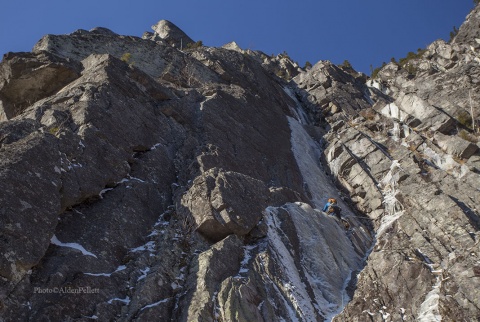
Ryan Stefiuk leading up pitch 1 of P’tite Tête, WI4+R,M6R, on Mont Gros Bras in Parc National des Grand Jardins in Quebec.. Thanks to thin ice, we found the guidebook rating was harder than the actual conditions we encountered. Easy mixed and thin ice at 4+R. Photo by Alden Pellett.
According to Guides des cascades de glace et voies mixtes du Quebec by Stephane Lapierre and Bernard Gagnon:
Notable winter routes:
“P’tite Tête,” WI4+R,M6R. 175M.
“Gaston et mademoiselle Jeanne,” WI4,M5R. 180M. Just to the right of the previous route.
“All Fine,” WI4+,M5R. 180M. This is the left-hand side of these obvious corner systems in the central part of the cliff.
“Hals und Beinbruch,” M6+. 230M.
Approach: Cross the road next to a yellow ‘500M’ truck sign, and look for orange contractor tape marking a route through the woods, crossing the brook, and then trending up the right of the talus field below the main cliff face. The woods above get fairly dense and steeper the closer to the cliff you get. This appears to be the easiest path to and from the cliff face. Trust me, we didn’t come down that way and it was a nasty bushwhack.
Notable winter routes:
“Convention Collective,” WI4+R. 90M
“La Retour des Crapauds (Return of the Toads),” WI5+R. 130M
There are a number of appealing corners of thin ice, turf, and mixed corners that have been climbed to the right of this route.
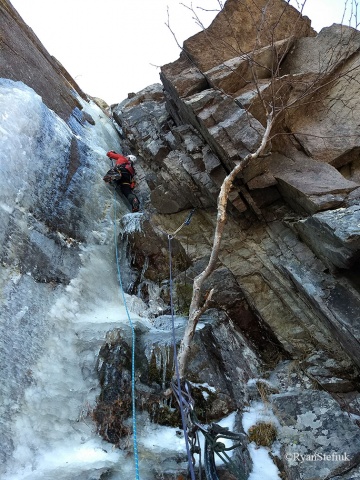
Alden Pellett leads up pitch 2 of the mixed route, “P’tite Tête,” on Mont Gros Bras in Parc National des Grand Jardins in Quebec.
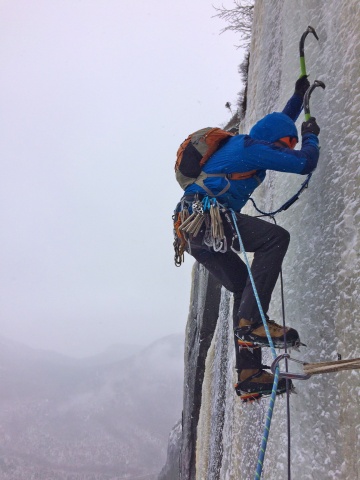
Ryan Stefiuk heads up the crux headwall on “Retour des Crapauds”(Return of the Toads) on the Mur des Crapauds Wall.
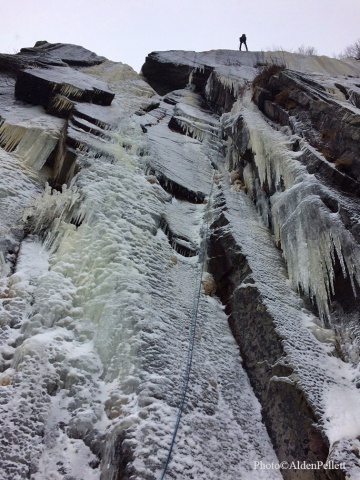
Pitch one of the ice climb “Retour des Crapauds.” in Parc National des Grand Jardins. It gets a WI5+R in the guidebook. We found conditions much easier, more like WI4+(WI4R).
There are places for lodging in St. Urbain but we chose to stay near the bigger town of Baie St. Paul for a better selection of restaurants and services.
Baie St. Paul
You can spend between $75 to over $156CDN per night.
Hotel des Cascades – Offers what is probably the most inexpensive night’s lodging. No frills but clean and right near downtown. Recently redone rooms.
Hotel Baie St. Paul – Much along the same vein as des Cascades. Inexpensive but fairly clean and near enough to downtown.
Hotel and Spa Le Germain Charlevoix – Pricey, but pretty inclusive. Restaurants onsite and more.
Tim Hortons for a quick breakfast, of course. it is just down the main drag in town. There is a McDonalds, too. Check out a few of the local restaurants if you have time for a sit-down breakfast.
Joe Smoked Meat – Pleasant interior. Good inexpensive sandwiches on the menu plus a spaghetti plate with sauce. Get it with the smoked meat plate if you want a good but different-looking meal. 😉
There are a number of very nice eateries along the Rue Ste. Jean Baptiste in town like Le Cafe des Artistes. Check them out!
* Zoom, Scroll and click Icons for Information & Driving Directions
You might also like this post by Ryan Stefiuk: A Road Trip – Newfoundland 2015
Michael Wejchert, Ryan Driscoll, and Justin Guarino take New Hampshire’s presidential range traverse to a whole new level. – The Technical Traverse.
by Michael Wejchert
I pulled over on the side of the trail: a spot I usually stop with clients to enjoy a lunch break on the third day of Presidential traverses. The rain kept pouring down. We were soaked to the bone. I unzipped Justin’s jacket just a little bit, bent over, and heaved up 400 calories of salami, a liter of water, and the coffee I’d forced down four hours earlier. Ryan and Justin collapsed on their packs. I zipped the jacket back up and wiped my mouth.
“I don’t think I got puke on the jacket, Justin.” It was my first time climbing with him.
Killian Jornet isn’t likely to visit the White Mountains anytime soon. Nobody’s drawn to spruce traps, or short ice climbs, or knobby little summits with weird buildings on top. The terrain isn’t sexy, or long. New Englanders are really great at ice climbing, or climbing on granite, but we’re bad at long days in the mountains; if you want a long alpine day, you’ve got to get really creative. The trick lies in trying to do a lot with a little.
One day, while pouring over the ice-climbing guidebook, I came across Kurt Winkler and Doug Huntley’s “Link ‘em Up,” an enchainment of ice climbs in the Presidentials over three days. I was also deeply impressed with Alan Cattabriga and Gabe Flanders’ efforts to link three ice climbs with a full traverse, from Webster to Madison.
King Ravine, Mad Gulf, the Great Gulf, Huntington Ravine, and Tuckerman’s, all ravines with established climbs, in addition to the nine summits of a standard guided winter traverse: 5,000 feet of climbing or mountaineering, and 27 miles of hiking. I started calling it the “Technical Traverse.” It’d take three days; you’d need to carry a firstlight, a sleeping bag, and food. But then again, while trail running in the Tatra Mountains of Poland a few summers ago, I came across the account of Slovakian Dodo Kopold’s nonstop traverse of the Tatra Mountains, linking up climbs and summits; out went the bivy kit. You’d just need a stove to stay hydrated, a pair of ice tools, crampons, microspikes, (it’s New England), and a puffy jacket!
For three years, I dreamed about pulling off the traverse. Only in the spring, with good snow and perfect neve, would it be possible. Normally, the temptations of clipping bolts in the sun won out. But this year I tore the labrum in my right shoulder on a sport climb. I’d have to hold off on rock climbing until I got surgery, which I opted to do in the springtime. So I just ran a lot, sometimes logging forty to sixty trail-running miles a week. As I guided mountaineering courses and presidential traverses throughout the winter, I piled weight in my pack, often carrying upwards of 65-70 pounds for hours on end, and my legs transformed with that specific mountain endurance you can’t get from Crossfit or trendy stadium workouts.
The warm-up last week was heartbreaking for ice climbers and skiers, and for anyone concerned about our environment. It devastated our snowpack. I went from skiing fresh, perfect powder to guiding in the rain. But it also meant that, if it got cold, even briefly, the entire range would be coated in perfect alpine neve. There was a short window where the temperatures were slightly below freezing, and the wind was quiet enough to warrant speedy moving. Problem was, it would only last about twelve hours before turning to warm, freezing rain. But, if we finished our last climb, we could always suffer through a little rain for the last nine miles of easy walking.
We started hiking at 7:15 a.m., figuring it’d be better to get a full night’s sleep than start super-early. We were in for plenty of night climbing, anyway. We forced ourselves to go slowly up the Valley Way trail, then dumped our packs to drop into Mad Gulf. It was potentially the cruxiest part of the day, but we raced down before the warm sun began melting the ice too much. The ice climbs in the Madison Gulf are awesome: perfect, warm sticks and a beautiful setting. We picked the one Kurt Winkler and Doug Huntley had done on their traverse—a great WI4 line. We trudged up corn snow and summited Madison. Four hours. Good. The sun beat down. We drank from ice melting off the roof of Madison hut, and continued on down into Great Gully in King’s Ravine. This was our easiest climb, and next time I’d opt for “PF Flyer,” something more difficult, though that climb requires bushwhacking that we didn’t have time for. More meltwater, a trudge back up the 600-800 feet or so, to summit Adams. We moved over Jefferson, down into Sphynx col, and spent an hour brewing up more water and eating. Nine hours in. We summited Clay, and dropped into the Great Gulf, and down-climbed perfect neve. We each picked a fun little mixed rib to climb up—the climbing was so much more enjoyable than the hiking, especially without packs. The terrain was classic, easy ravine climbing, with turf-shots, ice, neve, and little mixed bulges. We front-pointed back up to Clay and slogged up Washington. By now, fog was setting in, though it was still clear enough to see town sporadically.
At nightfall, we summited. “We are about to enter the Upside Down,” said Justin, quoting the Netflix show Stranger Things. As the darkness fell, our legs would feel a little more tired, and everything would feel a little bit harder. We down climbed Central Gully into Huntington Ravine, and started up Pinnacle. It was undermined, and actually kind of scary, especially after twelve hours of moving and having three people soloing at the same time. We carefully picked our way up so as not to break the old ice and fall into the waterfall below.
We texted our respective significant others to let them know we were alright, hiked across the Alpine Garden, and bailed into Right Gully in Tuckerman’s Ravine. Another brew stop, taking advantage of the running water by the Ranger Station. We had initially planned on climbing a mixed runnel up the Boott Spur, but we were so exhausted that simply climbing up Hillman’s Highway was good enough. It was ten o’clock. We all felt nauseous as we crunched up the long, terrible slope. The second we reached the top, it began to rain.
We’re in it now. I pulled the GPS out. We couldn’t see fifteen feet. The Upside Down. We’d always thought it’d be over the second we topped out Tuck’s – a victorious slog to the road. My GPS died as we reached Lakes, and we took a compass bearing from the sign. It took us nearly an hour to find the hut from 0.1 miles away. I’ve been there hundreds of times, more than that, in all sorts of weather, but I’ve never encountered fog like that. I headed in a general direction to reach Monroe, where the trail gets easier. I was completely soaked through in my Houdini Jacket and soft shell pants. The down puffy in my pack wouldn’t help much, either. We went from cairn to cairn. If I couldn’t find the trail, I’d yell “Stop!” and the Rhino would hold fast to the last cairn and we’d stretch out as far as we could see each other—a hundred feet or so, and sweep around. It got easier as we wove down the Crawford path, but each time we stopped, I’d start shivering uncontrollably. We were all pretty darn close to hypothermia.
“Michael,” said Justin. “When’s the last time you ate or drank?” He was right. Having three people was starting to seem like a good idea, if for nothing else besides a little bit of control. He gave me his synthetic jacket—a lifesaver. A slog with tired legs over Eisenhower and Pierce, some vomiting (I’m always the one to vomit), and then all we had to do was force ourselves down to the Highland Center. It got warmer in the trees, as the windy, sideways rain gave way to mist. We arrived at 3:30 a.m., twenty hours and fifteen minutes after starting. We’d done it! Ryan started to get excited, “You could do a hut-to-hut traverse with ice gear, and end on the Black Dike!” But, after driving back home, soaked to the bone, all I wanted to do was sleep.
A few more photos:
[ngg_images source=”galleries” container_ids=”74″ display_type=”photocrati-nextgen_basic_thumbnails” override_thumbnail_settings=”0″ thumbnail_width=”240″ thumbnail_height=”160″ thumbnail_crop=”1″ images_per_page=”20″ number_of_columns=”0″ ajax_pagination=”0″ show_all_in_lightbox=”0″ use_imagebrowser_effect=”0″ show_slideshow_link=”0″ slideshow_link_text=”[Show slideshow]” order_by=”sortorder” order_direction=”ASC” returns=”included” maximum_entity_count=”500″]A large size map of the Technical Traverse in PDF by Marc Chauvin
Related Story
Playing Pachinko on Mt- Webster
It’s been a great year for “Black Pudding Gully”. Hardly a gully, this climb can be steep and challenging at times, but it is fat and wide this year. And has seen a lot of traffic. It has been many years since I have climbed it, so we figured we would go have a look. Surely by now it would be stepped and hooked out making for an easy solo. Just what we needed, a little physical and mental exercise for our midday break. But we were late and two other parties of three were in front of us having fun climbing this classic line. So we took a line less traveled. A nice ice flow just to the right. It was steep and candled but Alden took one look and said “If I can’t climb that, I should not be going to Newfoundland”. He walked right up it with grace and confidence. I followed, it was just what I was looking for. BAKP showed us she is ready for harder climbs making it to the top easily with only a few squeaks ;-). Off I went to heat up the soup. Fred followed the climb and then, the Black Pudding Gully was standing alone, ready for Alden to climb before heading back for his Ice Fest responsibilities.
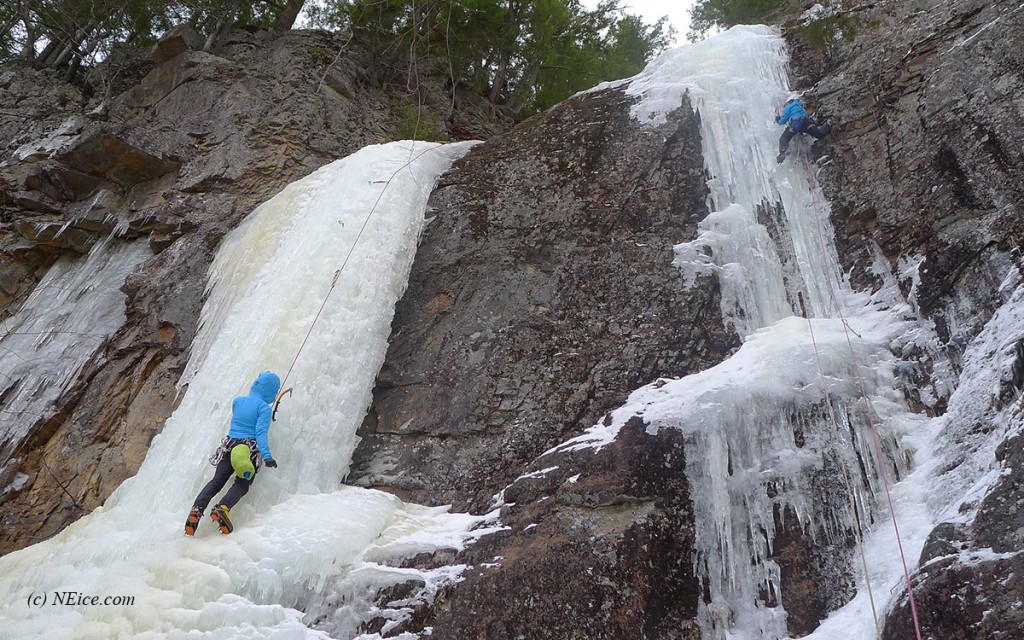
Don’t be deceived, the climb is very for-shortened in this photo. It’s longer and more vertical than it appears on both climbs. Black Pudding Gully on the left, Alden climbing on the right.- Doug Millen
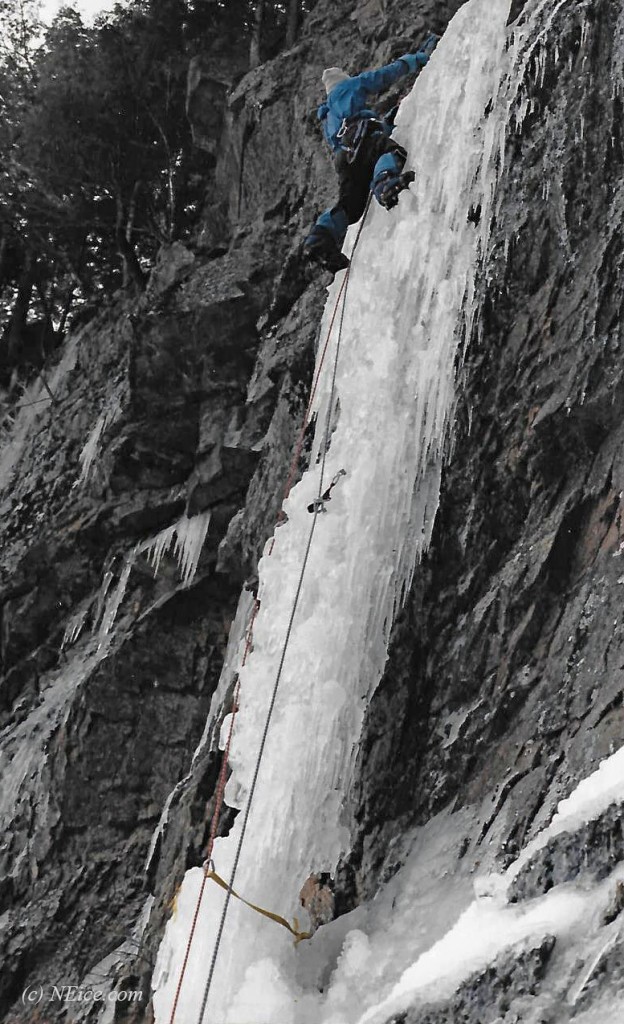
Me climbing Black Pudding Gully in the 80’s…Note the lack of a helmet, and the straight shaft tools you can’t see. I slung the column then put in two airated screws, and then headed to the top for good gear.
I love this event!!! So good to see everyone. It’s like a big family reunion! My only regret is not enough time to do all I wanted to do, or enough time to spend with everyone I wanted to see. I can’t wait till next year.
Many thanks to the MWV Ice Fest crew for all the hard work they do to put this event together. Thanks to all the sponsors that make this event possible. And to the guides for sharing their expertise of this amazing sport. And IME and Theater In The Woods for hosting, and to IMCS for coordinating all the guides. And thanks to all of you that attended, to make this the biggest, and best Ice Fest in the North East!
– Doug Millen
Solo had a great time at the 20th ADK Mountainfest and captured some spectacular images. His first trip to the Adirondacks and he can’t wait to return. Many thanks to The Mountaineer and Rock and River for all the hospitality.
Photos by Solo, flown by Doug Millen
by Ryan Stefiuk – bigfootmountainguides.com
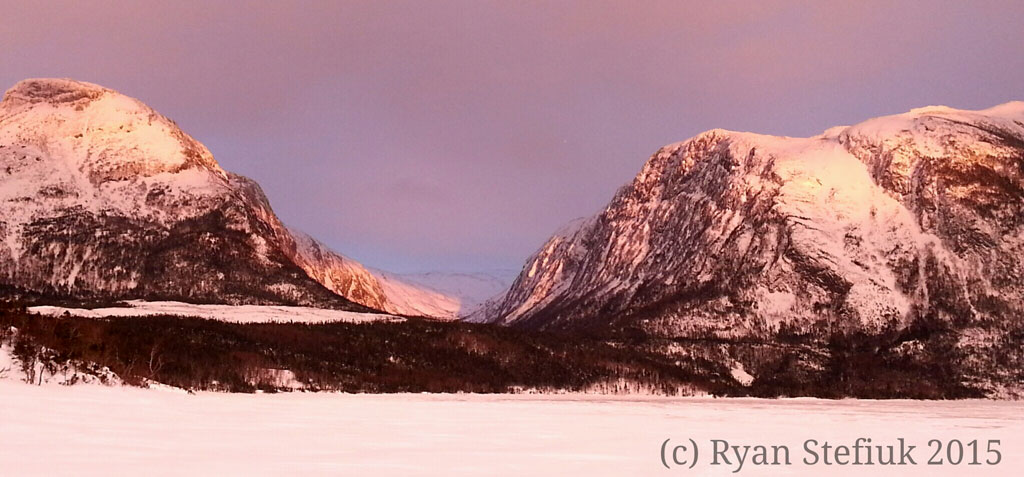
The MV (marine vessel) Leif Ericson crunches through sea ice in the Cabot Strait. The ship’s hull groans and 2-3 meter thick ice buckles underneath. Cracks in the ice expose the intimidating midnight blue waters of the North Atlantic. I see the long low hills of the Cape Breton Highlands off to my right, signaling our arrival in Nova Scotia and the end of my stay in Newfoundland. Leaving this place is always bittersweet. 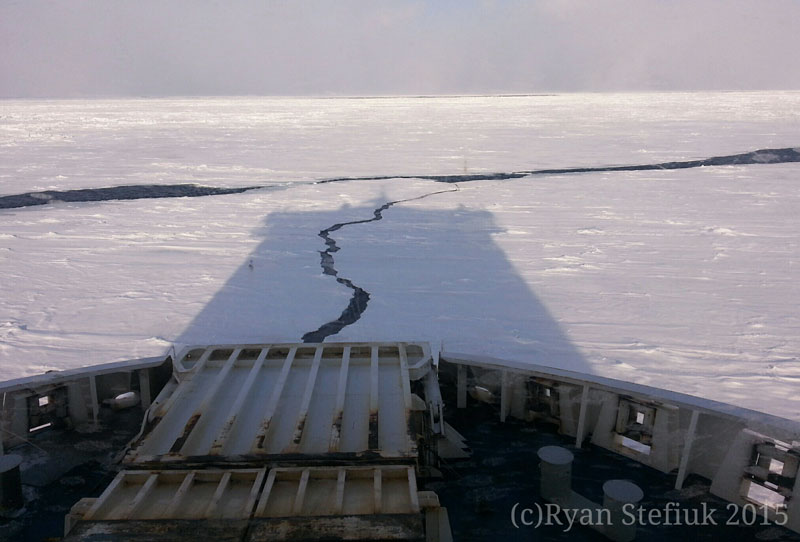 Winter trips in hideously cold weather make me long for home; to share a warm space on my couch or bed with my partner and dog. Newfoundland’s landscape and it’s people captivate me though and it saddens me to leave. I am deeply satisfied yet physically spent and tired of the cold.
Winter trips in hideously cold weather make me long for home; to share a warm space on my couch or bed with my partner and dog. Newfoundland’s landscape and it’s people captivate me though and it saddens me to leave. I am deeply satisfied yet physically spent and tired of the cold.
How does one measure the success of a climbing trip? Is it by how hard one climbed, or by whether one sent their project? Is it by the number of days climbed, areas visited, or routes completed? Can you measure success with first ascents? How about by the number of friends made or visited along the way?
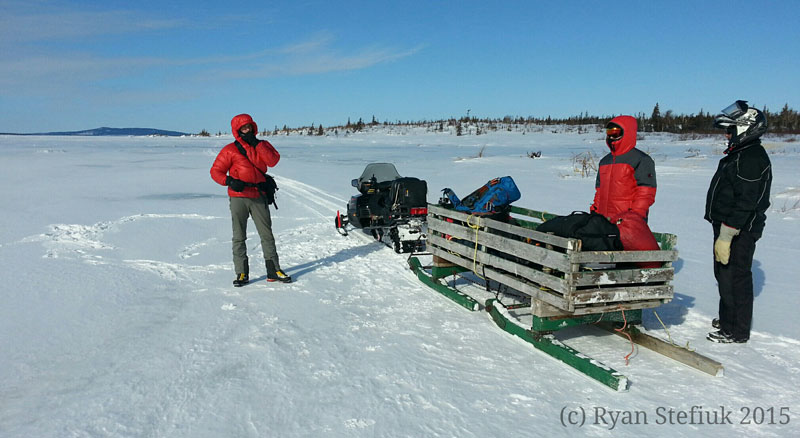 It’s hard for me to say exactly what made this trip to Newfoundland successful. Alden Pellett, Christopher Beauchamp and I got along great and laughed often, and that counts for a lot on any extended trip. Deep in the Newfoundland backcountry we climbed several really long ice lines – some as long as 1800′. Several of the lines we climbed were probably first ascents and check in at WI5+ or WI6. We climbed classic ice lines established by the Joe’s – Joe Terravecchia and Joe Josephson – on a wall that’s as classic as any 3 pitch wall in North America. We made new friends and reconnected with old ones. Newfoundland is famous for having gracious and hospitable people, and my expectations are continuously surpassed.
It’s hard for me to say exactly what made this trip to Newfoundland successful. Alden Pellett, Christopher Beauchamp and I got along great and laughed often, and that counts for a lot on any extended trip. Deep in the Newfoundland backcountry we climbed several really long ice lines – some as long as 1800′. Several of the lines we climbed were probably first ascents and check in at WI5+ or WI6. We climbed classic ice lines established by the Joe’s – Joe Terravecchia and Joe Josephson – on a wall that’s as classic as any 3 pitch wall in North America. We made new friends and reconnected with old ones. Newfoundland is famous for having gracious and hospitable people, and my expectations are continuously surpassed.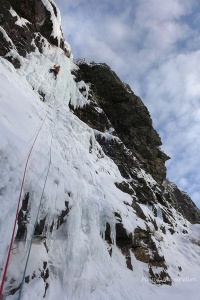
Over the years many people have climbed ice in western Newfoundland (pronounced newfin-LAND, with the accent on “land”). Paul Fenton, an outfitter in Nain, Labrador, climbed in many of the fjords, and Jim Bridwell spent some time there in the 90’s with him. In the late 90’s Joe Terravecchia and Casey Shaw began climbing there. They have explored the area heavily over the last 20 years, and have brought many other northeasterners along during that time.
It was one of Joe’s slideshows at the Adirondack Mountainfest that finally encouraged Alden Pellett and me to visit for the first time back in 2008. Initially, Joe and Casey were deliberately vague about where and what they’d climbed. This peeved me. I didn’t understand why anyone would be so secretive about the locations of climbs. Did they care so much about first ascents that they were unwilling to share information? Maybe, but I don’t think so. After five trips to the island, and 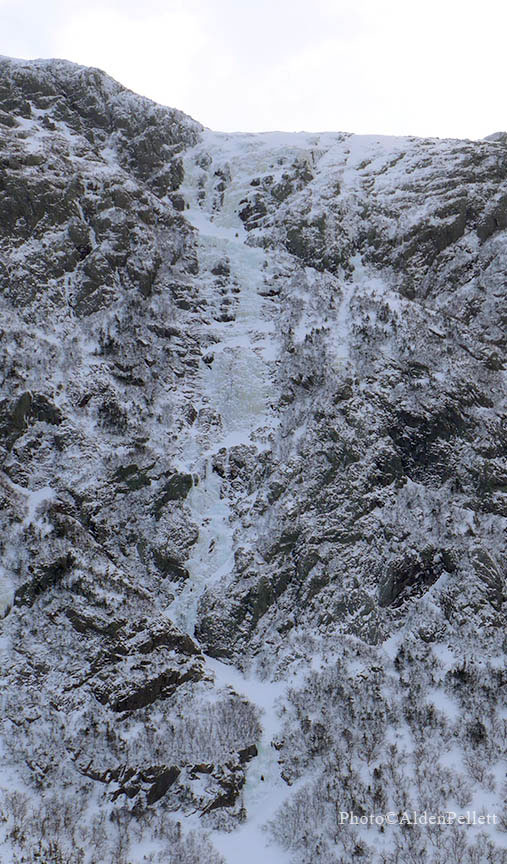 visits to many of the fjords, I realize the brilliance of their decision to keep quiet. It takes two days to get to Newfoundland during good weather. The wind and blowing snow is hideous. The climbs are all in the backcountry. There are no other climbers, no guidebooks, no bolts, and no chance of a timely rescue if something goes wrong. Ice climbing in Newfoundland is about adventure.
visits to many of the fjords, I realize the brilliance of their decision to keep quiet. It takes two days to get to Newfoundland during good weather. The wind and blowing snow is hideous. The climbs are all in the backcountry. There are no other climbers, no guidebooks, no bolts, and no chance of a timely rescue if something goes wrong. Ice climbing in Newfoundland is about adventure.
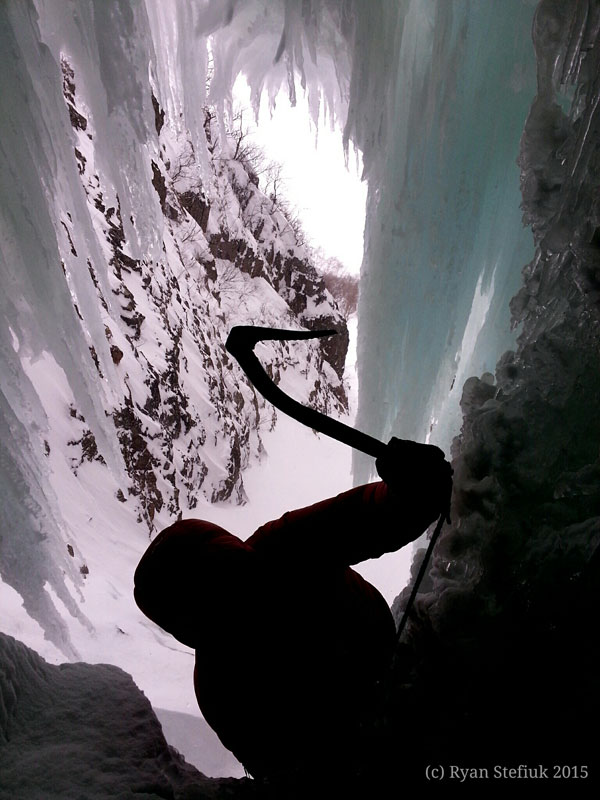 I know I’ll be back again. Maybe not next winter because I’ll be in nursing school. After that for sure though. Like those that have come before me, my vagueness about climbing in Newfoundland is deliberate. I want to preserve the experiences I’ve had and cherish so that others can be as fortunate as I have been.
I know I’ll be back again. Maybe not next winter because I’ll be in nursing school. After that for sure though. Like those that have come before me, my vagueness about climbing in Newfoundland is deliberate. I want to preserve the experiences I’ve had and cherish so that others can be as fortunate as I have been.
Many thanks to Terry Hynes, Bevin Goosney, Brad and Lamont Thornhill, Clayton, Rick Endicott, and Walt Nichol for showing us true Newfoundland hospitality. Thank you Casey Shaw and Joe Terravecchia for showing me the Newfoundland way. Thank you Michael and Alexa for letting us crash in North Conway before and after our trip and to Rob and Amy for letting us store a car in North Conway. All of these individuals helped make this year’s trip a great success.
By Matt Ritter
From the exposed ledges of the Whitney Gilman Ridge it would call to me. I’d snap seemingly random photographs and stare distractedly. I’d remind myself that as a guide I should remain focused. The giant corner system above the Cannonade Buttress is exposed and looms over the talus like an inverted cargo train. The steep face below is split by a series of cracks and seams that I visually kept following back to the base of this massive corner. In the winter, I’d rack up and wonder about the imposing prow which starts as a large corner, briefly evaporates mid cliff, and reasserts itself in steep prominence like a wave threatening to break on the talus beach.Despite having made five attempts on this route with various partners, I knew that I could put it to rest this time. The source of this confidence being an extra five feet of ice not present during my last lean condition attempt. This ice made me think I wouldn’t need to place gear in the seemingly unprotectable terrain above my highpoint.
I have climbed on this route with some of the greatest members of our climbing community. Today was no exception, Jim Shimberg owner of Rhino Guides kept telling me I was “grilled” as we made upward progression. The icy cracks of the first pitch felt heavenly and went quickly. Snow conditions were perfect which made the technical pitch two traverse a sidewalk.
Pitch three is where the business begins. Off the piton anchor, I clip a nest of gear and situate myself at the first crux where a splendid vertical slab becomes slightly overhanging. With both tools over my shoulder, I side pull crimp an edge, step my front points high onto nothing, and at full extension I virtually kiss my ice tool ‘goodbye’ to wrangle a solid matchable edge. Committed, a fall from here would land me below the belayer in a big swinging arc. Better not to fall. A couple solid tool placements and strenuous lock offs allows me to clip a great piton and bust some layback moves on a flake to gain a rest beneath a small roof.
Reaching out over my left shoulder, I pull through the roof and high step into the next crux which feels like muckling a greased refrigerator with an iced up rattly hand crack on the left and an equally slick rattly finger crack on the right. Surmounting this block feels monumental. After some steep cranking, I gain a good stemming rest and a short flaring corner that becomes an in-cut, kinda sidepull rail with good hooks and some tiny gear. Stellar, exposed climbing gains a tiny ledge which, with a micro wire, and a tiny fixed pecker a body length beneath my feet, provided much spice to mantle. Placing a great piton awkwardly at my knees, I was just a few moves from mantling onto the icy sloping ledge above. I’ve always said I was gonna kiss this ledge when I got there. Tough to describe the exuberance I felt from finally reaching this point. The rest of the pitch isn’t easy but comparatively its a walk in the park. I knew it was in the bag.
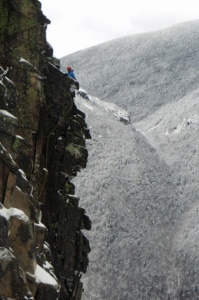
Topping out Cannonade Direct. Pitch 4 is a wonderful rock finish with good gear and cracks! Photo by Steve Robitshek
Michael Wejchert, and I met at Cannon Cliff the next day. I wanted to climb a variation to Cannonade Direct that would allow me to climb the entirety of the monstrous upper corner. Being a little sore from the previous three days of strenuous climbing, I slurped multiple infusions of Mate and blasted Rage Against the Machine. Another warm day. At the base of Cannonade Direct I racked up. Having climbed this amazing pitch five times, I have it rather dialed. I torqued iced up cracks, stemmed familiarly, and sloppily sped up the 65 meter pitch. Now for the variation! I situated myself under the first crux and placed a couple bomber knifeblades. A right arching seam catered minuscule technical edges and tenuous high steps. The rock is bomber but I enjoyed a handful of whippers due to exploding micro flakes. Making these technical face moves earned me some awe-inspiring hooks and the most elegant horizontal finger crack which welcomed the necessary gear and an adequate rest before the next crux of gaining the ice.
I tapped my battered picks into the snowy little ledge. The ¼ inch space between ice and granite dispelled any myth of security. Wet snow pressed heavily on this precarious substrate. The rock beneath my ice tools was overhanging. I hoisted my front points up to my elbows placing them on perfect ⅜ inch edges. Finally some large footholds!! Here, with my ass in space and my ice tool moving to more secure rotten worthless ice, the ledge and ice curtain detach indifferently. Taking a big clean fall onto a bomber Lost Arrow I come tight on the rope before reaching terminal velocity. My head was down and I could see Michael looking at me as generously plump chunks of aerated ice pummeled me. Without lifting my head, Michael and I made eye contact. “I guess you’ll have to wait for a colder day.” Michael is smarter than I am. “I’m making it to that belay. I think it just got easier.”
I know I’ve got one shot. The holidays are upon us. The rain is upon us. My early season project’s ice will not form again. I lower to the ledge and fire the crux, pull gingerly onto the steep ice and build a belay at the base of the mythical corner.
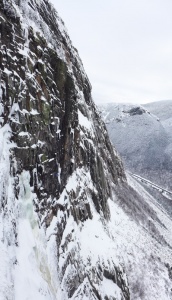
P3 Cannonade Direct. Cannonade Direct Direct climbs into the base of the big brown corner via the ice smear to my right. Photo by Bayard Russell
Everything had felt pretty safe up to this point. Despite the repeated whips and long fall followed by a heat seeking deluge of frozen water missiles, I was climbing very well and felt invincible. Obviously mixed climbing is dangerous. Nothing about climbing Mean Streak, Prozac, or Daedalus is “safe.” In fact these climbs provide one with many opportunities to get hurt. I firmly believe that in these situations our safety hinges upon our mental state. There will always be objective hazard, but when I’m climbing well, I’m not climbing scared. Surviving one of these climbs by the skin of my teeth does not seem sustainable. No route is worth a broken ankle, face, or spinal cord. With that in mind, I pulled off the ledge and soon found myself with a couple cams a few feet beneath my boots. Cannon does in fact have pockets of very steep terrain. Trust me. I look for it. I was getting pumped and I almost bailed. Casually, I told Michael I might fall as I began to ponder my exit strategy. He didn’t argue but we both knew this wasnt gonna be pretty. Looking down, I saw a small edge. Still in control, I reminded myself that someday I wanted to be a bold climber. I looked up. In what felt like the boldest moment of my career, I forged upward. Now, too far above my gear to not hurt myself, perched on an overhanging arete above the talus, on a pitch I’ve lusted over for 3 seasons. I made one more move to a solid hook and a serendipitous cam placement. The climbing eased up slightly as steep snow filled cracks and an arete composed of gravity defying loose nonsense made me feel at home. Or was it that I wished I was at home? Either way, leaving my last gear behind and pulling around the corner onto featureless slabs covered in ½ inch snice kept my attention for the last 40 feet to the trees. Seriously, do not blow it here…
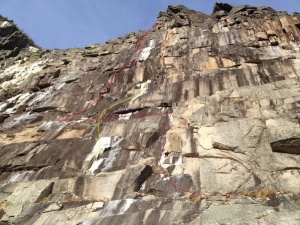
Cannonade Direct (red) and second to last pitch of Cannonade Direct Direct (yellow) in much leaner conditions.
(Click on images to enlarge)
A Dose of Prozac and Some Positive Thinking
Matt Ritter Joins the MWV Ice Fest Team

Your ice climbing connection for New England, the Northeast and Beyond!
